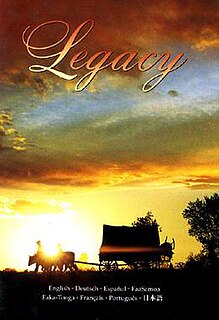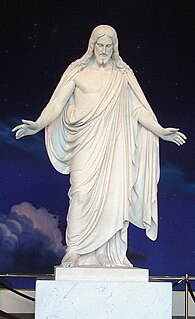Related Research Articles

Alexander Gordon Jump was an American actor best known as the clueless, yet occasionally wise, radio station manager Arthur "Big Guy" Carlson in the TV series WKRP in Cincinnati and the incompetent Chief of Police Tinkler in the sitcom Soap. Jump guest starred on a two-part episode of the 1980s sitcom Diff'rent Strokes, in which he portrayed a pedophile who tries to molest main characters Arnold and his friend, Dudley. He also played the "Maytag Repairman" in commercials for Maytag brand appliances, from 1989 until his retirement from the role in July 2003.
In Mormonism, Heavenly Mother or the Mother in Heaven is the mother of human spirits and the wife of God the Father. Collectively Heavenly Mother and Father are called Heavenly Parents. Those who accept the Mother in Heaven doctrine trace its origins to Joseph Smith, the founder of the Latter Day Saint movement. The doctrine became more widely known after Smith's death in 1844.

Eliza Roxcy Snow was one of the most celebrated Latter Day Saint women of the nineteenth century. A renowned poet, she chronicled history, celebrated nature and relationships, and expounded scripture and doctrine. Snow was married to Joseph Smith as a plural wife and was openly a plural wife of Brigham Young after Smith's death. Snow was the second general president of the Relief Society of The Church of Jesus Christ of Latter-day Saints, which she reestablished in Utah Territory in 1866. She was also the sister of Lorenzo Snow, the church's fifth president.

Lorenzo Snow was an American religious leader who served as the fifth president of The Church of Jesus Christ of Latter-day Saints from 1898 until his death. Snow was the last president of the LDS Church in the 19th century and the first in the 20th.

Orson Ferguson Whitney born in Salt Lake City, Utah Territory, was a member of the Quorum of the Twelve Apostles of The Church of Jesus Christ of Latter-day Saints from 1906 until his death.

Mormon cinema usually refers to films with themes relevant to members of The Church of Jesus Christ of Latter-day Saints. The term has also been used to refer to films that do not necessarily reflect Mormon themes but have been made by Mormon filmmakers. Films within the realm of Mormon cinema may be distinguished from institutional films produced by the LDS Church, such as Legacy and Testaments, which are made for instructional or proselyting purposes and are non-commercial. Mormon cinema is produced mainly for the purposes of entertainment and potential financial success.

The 1890 Manifesto is a statement which officially advised against any future plural marriage in The Church of Jesus Christ of Latter-day Saints. Issued by church president Wilford Woodruff in September 1890, the Manifesto was a response to mounting anti-polygamy pressure from the United States Congress, which by 1890 had disincorporated the church, escheated its assets to the U.S. federal government, and imprisoned many prominent polygamist Mormons. Upon its issuance, the LDS Church in conference accepted Woodruff's Manifesto as "authoritative and binding."

Celestial marriage is a doctrine that marriage can last forever in heaven. This is a unique teaching of The Church of Jesus Christ of Latter-day Saints or Mormonism, and branches of Mormon fundamentalism.

Legacy: A Mormon Journey is a 53-minute film produced by The Church of Jesus Christ of Latter-day Saints. Legacy depicts the life of two recent converts from the 1830s to the 1890s. The characters are fictional, though the events they experience are historical.

Mormon poetry is poetry written by members of The Church of Jesus Christ of Latter-day Saints about spiritual topics or themes. Mormons have a long history of writing poetry relevant to their religious beliefs and to the Mormon experience. Mormon poetry, like Mormon fiction, has experienced different periods throughout the LDS Church's history, including the "home literature" period and the "lost generation." Some Mormon poetry became church hymns.

The finances of The Church of Jesus Christ of Latter-day Saints are not a matter of public record. In the absence of official statements, people interested in knowing the church’s financial status and behavior, including both members of the church and people outside the church, have attempted to estimate or guess. According to the church, their funding comes from the donations of its members and the principal expense is in constructing and maintaining facilities.
Bookcraft was a major publisher of books and products for members of The Church of Jesus Christ of Latter-day Saints.

Wetzel Orson "Judge" Whitaker was a filmmaker and animator. He is most known for his early work as a Disney animator, particularly the animation of the stepsisters from Cinderella, and his work as a director for BYU Motion Picture Studios. Most of the films he was involved in, such as The Windows of Heaven, Johnny Lingo and Pioneers in Petticoats, were made in cooperation with his brother Scott Whitaker. The two of them ran the BYU Motion Picture Studio during this time, receiving commission from The Church of Jesus Christ of Latter-day Saints to make films.

One Hundred Years of Mormonism is a 1913 film depicting the early history of The Church of Jesus Christ of Latter-day Saints. The six-reel film took its title from the 1905 book by Mormon educator John Henry Evans. Ellaye Motion Picture Company was originally contracted by the church's leadership to produce the film, but the company broke its contract and was replaced by the Utah Moving Picture Company, with prominent screenwriter Nell Shipman completing the screenplay for a then-unprecedented fee of $2,500. Filming took place on locations across California and Utah. The filming locations in Utah were Salt Lake City, Daniel's Pass, and Heber.

LDS Motion Picture Studios (MPS) is a film studio based in Provo, Utah, and is a directly-managed division of The Church of Jesus Christ of Latter-day Saints.
The Mountain of the Lord is a 72-minute film produced by The Church of Jesus Christ of Latter-day Saints. It depicts the story of the building of the Salt Lake Temple in a fictional encounter between a reporter and Wilford Woodruff and was produced for the centennial of its dedication. The film shows the struggles of early Mormons to build the temple—which took 40 years to complete—in the Salt Lake Valley, where church members arrived in 1847.
How Rare a Possession is a 64-minute film produced by The Church of Jesus Christ of Latter-day Saints. It depicts the conversion stories of Parley P. Pratt, a church leader in the 19th century, and Vincenzo di Francesca, an Italian pastor in the 20th century, who both join the church after studying the Book of Mormon. It also shows several key scenes from the Book of Mormon.

The following outline is provided as an overview of and a topical guide to The Church of Jesus Christ of Latter-day Saints.

Tithing is a commandment accepted by various churches in the Latter Day Saint movement. In practicing tithing, adherents make willing tithe donations, usually ten percent of their income, to their church. It is based on both the biblical practice of paying tithes and modern revelation given to Joseph Smith and his accepted successors. For many of these churches, the law of tithing replaced or supplemented the law of consecration. The Church of Jesus Christ of Latter-day Saints emphasized tithing in the 1900s and 1960s to assist in paying church debts.
References
- ↑ Horne, Dennis B. (2014). "Reexamining Lorenzo Snow's 1899 Tithing Revelation". Mormon Historical Studies. 14 (2): 150–151. Archived from the original on 2016-03-31.
- 1 2 Bell, E. Jay (1994). "The Windows of Heaven Revisited: The 1899 Tithing Reformation". Journal of Mormon History. Mormon History Association, University of Illinois Press. 20 (1): 45–83. JSTOR 23286314.
- ↑ "Windows of Heaven". Mormon Literature & Creative Arts. Retrieved March 8, 2016.